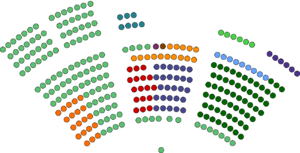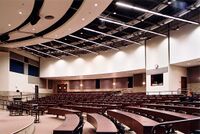Hérvynsken: Difference between revisions
No edit summary |
No edit summary |
||
| Line 1: | Line 1: | ||
{{WIP}} | {{WIP}} | ||
{{about|the bicameral legislature of [[Seketan]]|the national government|government of Seketan}} | {{about|the bicameral legislature of [[Seketan]]|the national government|government of Seketan}} | ||
{{Italic title}} | |||
{{Infobox legislature | {{Infobox legislature | ||
|background_color = lightblue | |background_color = lightblue | ||
Revision as of 01:09, 28 October 2023
This article is incomplete because it is pending further input from participants, or it is a work-in-progress by one author. Please comment on this article's talk page to share your input, comments and questions. Note: To contribute to this article, you may need to seek help from the author(s) of this page. |
Hérvynsken | |
|---|---|
| Type | |
| Type | |
| Houses | State Council Commons Council |
| History | |
| Founded | 1537 |
| Leadership | |
| Structure | |
| Seats | 398 293 Members of Hérvynsken 105 State councellors |
 | |
State Council political groups | Government (26)
Confidence and Supply (10) Opposition (120)
|
 | |
Commons Council political groups | 'Government (146)
Confidence and Supply (27) Opposition (120)
|
| Elections | |
| |
| |
State Council last election | 6 March 2023 |
Commons Council last election | 4 March 2021 |
| Meeting place | |
 | |
 |
|---|
| This article is part of a series on the politics and government of Seketan |
The Hérvynsken is the bicameral national legislature of Seketan. It is composed of the State Council as its upper house and the Commons Council as its lower house. Both chambers are based in the Hérvynsken Building in Conelibek.
The origins of the Hérvynsken start with the Secetan Imperium, where it is first mentioned by name as the official advisory council of the Kingdom of Seketan. Historians largely agree that the insitution was first organized earlier, probably around ~880 as a council of nobels to advise the king, similar to many European kingdoms at the time. During this time the Hérvynsken was not organized into "chambers" as it is today, but was composed of the Monarch and his advisors. The insitution evolved over the centuries as conflicts between the Monarch, his Dukes, and an ever increasing merchant class flared up intermediatly granting the Hérvynsken more power and authority. In 1673, a dispute over the annexation of Tjrebian land forced King Elysa II to agree to create two chambers within the Hérvynsken, a Commons Council and a Nobles council, as well as cede many authorities to the insitution. When Seketan entered a personal union with Alquiya in 1765, it was the Hérvynsken who approved gave their consent to the Alquiyan monarch to take the throne, placing themselves as integral to Seketans sovereignty.
In 1884 King Fjedor II announced the establishment of the Empire of Alquiya and Seketan, later theNelbec Empire, with the Hérvynsken sending representatives to the first Imperial conference for Seketan. Within the imperial framework, the insitution was positioned as the supreme authority in Seketan, only surplanted by the Emperor himself, and therefore had the power to enact laws within the Kingdom of Seketan regarding domestic affairs. In 1892 the Nobles council was reformed into the State Council to represent the newly made provinces. In 1914 the nationalist Kjedorate Party won a majority of seats, putting the Hérvynsken in conflict with the Empire at-large. The Hérvynsken would routinley pass motions opposing the direction of the war, such as opposing conscription, nationalization of certian industries, and tax increases.
Unrest within Seketan led to the outbreak of the Seketese revolution in 1918 and the uprisings of the Sosymets in Djenibek. On 12 August 1918, the Hérvynsken declared Seketese independence as the Republic of Seketan, starting the Seketese civil war. Upon the victory of the Kjedorates, and thereby the Hérvynsken, the legislature established itself as the supreme body within the state. In 1926 Seketan became a semi-presidential republic, with the President positing itself as above the Hérvynsken, though many of its historical powers and authorities remained in place. During the entirety of the Kjedorate regime, the body remained largely controlled by the Kjedorate party. With the
Current standings
| Party | Commons Council | State Council | |
|---|---|---|---|
| Our Revolution (MO) Mays Omysan |
126 / 293 |
26 / 106
| |
| Socialist Party (SY) Sošyça ynden |
59 / 293 |
25 / 106
| |
| National Conservative Party (CNy) Consyvaþeça Nasijoteça ynden |
27 / 293 |
10 / 106
| |
| Labour and Unionists Cooperative (OeUC) Ocisa e Uninui Cooperative |
17 / 293 |
10 / 106
| |
| Liberal Democratic Party (LDY) Libre democrateça ynden |
20 / 293 |
4 / 106
| |
| Wilsk National Party (WNY) Wyélš Našiyoteka yéden |
9 / 293 |
13 / 106
| |
| Freedom Alliance (FA) | 20 / 293 |
0 / 106
| |
| Green Party (AY) Azen ynden |
6 / 293 |
7 / 106
| |
| Party of Seketan (YaS) Ynden a Secen |
7 / 293 |
0 / 106
| |
| Progressive Party (PY) Progressija ynden |
1 / 293 |
0 / 106
| |
| Fjeska National Party (FNP) | 1 / 293 |
0 / 106
| |
| Independent | 0 / 293 |
11 / 106
| |